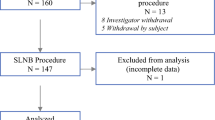Abstract
Background: Several reports have demonstrated the accurate prediction of axillary nodal status (ANS) with radiolocalization and selective resection of sentinel lymph nodes (SLN) in breast cancer. To date, no technique has proven to be superior in localizing the SLN.
Methods: 1.0 mCi of clear unfiltered99mtechnetium sulfur colloid was injected under ultraso-nographic (US) guidance around the perimeter of the breast lesion (palpable and nonpalpable) or previous biopsy site. Resection of the radiolocalized nodes was performed, followed by complete axillary lymph node dissection (AXLND).
Results: Forty-two breast cancer patients underwent SLN biopsy after US-guided radiopharmaceutical injection. The SLN was localized in 41 patients (98%). The type of previously performed diagnostic biopsy did not influence the ability to localize the sentinel lymph node. Pathology revealed nodal metastasis in 7 of the 41 evaluable patients (17%). ANS was accurately predicted in 40 of 41 patients (98%).
Conclusions: Early experience with radiologicalization and selective resection of SLN in breast cancer remains promising. Use of US-guided injection facilitates localization of the SLN, perhaps as a result of more accurate placement of the radionuclide marker. Use of this technique allowed for effective management of patients regardless of tumor size or the extent of prior biopsy, thereby expanding the potential number of eligible patients for SLN biopsy.
Similar content being viewed by others
References
Bonadonna G. Karnofsky Memorial Lecture: conceptual and practical advances the management of breast cancer.J Clin Oncol 1989;7:1380–97.
National Institute for Health Consensus Conference. Treatment for early stage breast cancer.JAMA 1991;265:391–5.
Maunsell E, Brisson J, Deschenes L. Arm problems and psychological distress after surgery for breast cancer.Can J Surg 1993;36:315–20.
Silverstein MJ, Gierson ED, Waisman JR, Senofsky GM, Colburn WJ, Gamagami P. Axillary lymph node dissection for T1a breast carcinoma.Cancer 1994;73:664–7.
Halverson KJ, Taylor ME, Perez CA, et al. Management of the axilla in patients with breast cancers one centimeter and smaller.Am J Clin Oncol 1994;17:461–6.
Walls J, Boggis CRM, Wilson M, Asbury DL, Roberts JV, Bundred NJ, Mansel RE. Treatment of the axilla in patients with screen-detected breast cancer.Br J Surg 1993;80:436–8.
Chadha M, Chabon AB, Friedmann P, Vikram B. Predictors of axillary lymph node metastases in patients with T1 breast cancer: a multivariate analysis.Cancer 1994;73:350–3.
Cady B. The need to reexamine axillary lymph node dissection in invasive breast cancer.Cancer 1994;73:505–8.
Morrow M. Axillary dissection in breast cancer: what role in managing BrCa?Contemp Oncol 1994;4:16–27.
Deckers PJ. Axillary dissection in breast cancer: when, why, how much, and or how long? Another operation soon to be extinct?J Surg Oncol 1991;48:217–9.
White RE, Vezeridis MP, Konstadoulakis M, Cole BF, Wanebo HJ, Bland KI. Therapeutic options and results for the management of minimally invasive carcinoma of the breast: influence of axillary dissection for treatment of T1a and T1b lesions.J Am Coll Surg 1996;183:575–88.
Morton DL, Wen DR, Wong JH, et al. Technical details of intra-operative lymphatic mapping for early stage melanoma.Arch Surg 1992;127:392–9.
Giuliano AE, Kirgan DM, Guenther JM, Morton DL. Lymphatic mapping and sentinel lymphadenectomy for breast cancer.Ann Surg 1994;220:391–401.
Giuliano AE, Dale PS, Turner RR, Morton DL, Evans SW, Krasne DL. Improved axillary staging of breast cancer with sentinel lymphadenectomy.Ann Surg 1996;222:394–401.
Alex JC, Weaver DL, Fairbank JT, Krag DN. Gammaprobe-guided lymph node localization in malignant melanoma.Surg Oncol 1993;2:303–8.
VanDerVeen H, Hoekstra OS, Paul MA, Cuestra MA, Meijer S. Gamma-probe-guided sentinel node biopsy to select patients with melanoma for lymphadenectomy.Br J Surg 1994;81:1769–70.
Albertini JJ, Cruse CW, Rappaport D, et al. Intraoperative radio-lymphoscintigraphy improves sentinel lymphMDBO MDNMnode identification for patients with melanoma.Ann Surg 1996;223:217–24.
Krag DN, Weaver DL, Alex JC, Fairbank JT. Surgical resection and radiolocalization of the sentinel lymph node in breast cancer using a gamma probe.Surg Oncol 1993;2:335–40.
Albertini JJ, Lyman GH, Cox C, et al. Lymphatic mapping and sentinel node biopsy in the patient with breast cancer.JAMA 1996;276:1818–22.
Ross ML, Reintgen DS, Balch CM. Selective lymphadenectomy: emerging role for lymphatic mapping and sentinel node biopsy in the management of early stage melanoma.Semin Surg Oncol 1993;9:219–23.
Reintgen D, Balch CM, Kirkwood J, Ross M. Recent advances in the care of the patient with malignant melanoma.Ann Surg 1997;225:1–14.
Alazraki N. Lymphoscintigraphy and the intraoperative gamma probe.J Nucl Med 1995;36:1780–3.
Alex JC, Krag DN. Gamma-probe-guided localization of lymph nodes.Surg Oncol 1993;2:137–43.
Uren RF, Howman-Giles RB, Thompson JF, Malouf D, Ramsey-Stewart G, Niesche FW, Renwick SB. Mammary lymphoscintigraphy in breast cancer.J Nucl Med 1995;36:1775–80.
Boak JL, Agwunobi TC. A study of technetium-labeled sulfide colloid uptake by regional lymph draining of tumor-bearing area.Br J Surg 1979;65:374–8.
Miner TJ, Flicek P, Jaques DP, Krag DN, Shriver CD. Guidelines for the safe use of radioactive material during sentinel node biopsy (abstract). Presented at the Annual Meeting of The Society of Surgical Oncology, Chicago, Illinois, March 1997.
Veronesi U, Paganelli G, Galimberti V, et al. Sentinel-node biopsy to avoid axillary dissection in breast cancer with clinically negative lymph nodes.Lancet 1997;349:1864–7.
Author information
Authors and Affiliations
Additional information
The opinions and assertions herein are the private ones of the authors and are not to be construed as official policy or reflecting the views of the Department of Defense.
Support for this work provided by the National Cancer Institute (grant U01 CA65121 — 02).
Rights and permissions
About this article
Cite this article
Miner, T.J., Shriver, C.D., Jaques, D.P. et al. Ultrasonographically guided injection improves localization of the radiolabeled sentinel lymph node in breast cancer. Annals of Surgical Oncology 5, 315–321 (1998). https://doi.org/10.1007/BF02303494
Issue Date:
DOI: https://doi.org/10.1007/BF02303494




